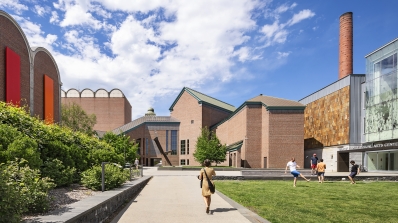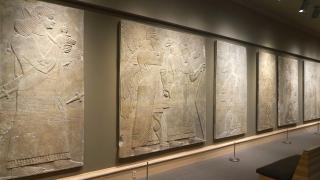Exhibitions Archive
Three Decades of Dance Photographs
Pilobolus Comes Home
Pilobolus Dance Theatre, founded by Dartmouth students in 1971, has changed the course of contemporary dance through its signature style of closely combined bodies and its radically innovative approach to collaborative artistic creation. Dartmouth celebrated Pilobolus's donation of its remarkable archives with a residence, performances, educational programs, and this exhibition at the Hood of stunning photographs chronicling thirty-five years of the company's work.
The Hood Museum of Art's Assyrian Reliefs, 1856–2006
From Discovery to Dartmouth
The year 2006 will mark the passage of 150 years since the arrival at Dartmouth of one of the college's most prized possessions in the realm of art and culture: the Assyrian reliefs, currently on display in the Kim Gallery of the Hood Museum of Art. Originally part of the decorative scheme of the so-called "Northwest Palace" of King Ashurnasirpal II (883-859 BCE) in Nimrud, Iraq, six large-scale reliefs depict a ritual performance undertaken by the king. Human and supernatural beings are also in attendance. Scholarly understanding of Assyrian art has increased considerably over time, as its visual, cultural, and historical meanings have been studied from a variety of perspectives and their role as visual propaganda has been recognized.
Contemporary Art from the Arctic
Our Land
Our Land is the first major museum exhibition of contemporary art from Canada's newest territory, Nunavut. On loan from the Peabody Essex Museum and the Government of Nunavut, this exhibition features about sixty works from the important Nunavut Territorial collection of contemporary Inuit art, which celebrates the growth of Inuit creative expression over the past five decades. The exhibition is presented by the Hood in recognition of International Polar Year 2007-8 and in conjunction with the exhibition Thin Ice: Inuit Traditions within a Changing Environment.
Resource Wars in the American Arctic
Subhankar Banerjee
This exhibition features four monumental habitat photographs taken by Subhankar Banerjee during his recent sojourns into the Arctic National Wildlife Refuge to photograph this remote region in northeastern Alaska in all four seasons. His work there coincided with the push by oil companies and the current U.S. administration to open up the oil and gas reserves on the coastal plain to drilling. During his travels over nearly four thousand miles of the 19.5-million-acre refuge by foot, raft, kayak, and snowmobile, he stayed in interior and coastal villages with both Gwich’in Athabascan and Inupiat families, absorbing their close and intricate relationships to the northern environment and the birds and animals that thrive there.
The impetus for this exhibition, which focuses on the Hood Museum of Art’s Inuit collections and celebrates Dartmouth’s long involvement in Arctic Studies, is the International Polar Year 2007-2008. Thin Ice explores traditional Inuit life through the nineteenth- and early-twentieth-century art and artifacts that indigenous Arctic peoples used to survive within this challenging environment. With the understanding that the Arctic environment is undergoing rapid transformation from climate change and the significant melting of sea ice, the exhibition highlights the impact of such change on Inuit ways of life and their relationship to the region in which they live. An illustrated catalogue accompanies this exhibition.
Lines of Text

